Kingdom Plantae Family Asteraceae Genus Centaurea Rank Species | Order Asterales Tribe Cynareae Scientific name Centaurea maculosa Higher classification Knapweeds | |
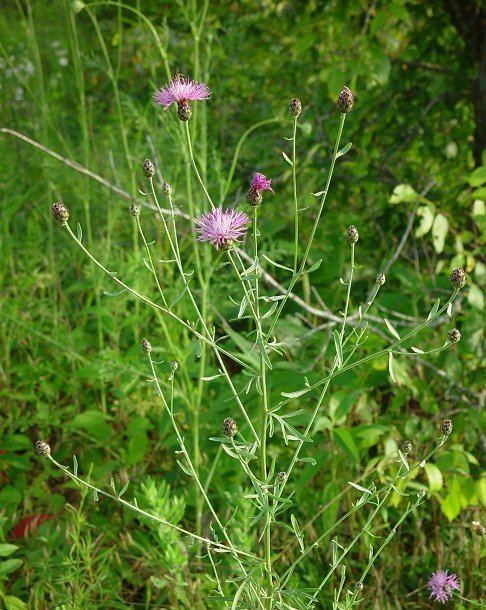 | ||
Similar Knapweeds, Centaurea diffusa, Euphorbia esula, Centaurea solstitialis, Russian knapweed | ||
Centaurea maculosa is a species of flowering plant in the family Asteraceae.
Contents
Introduction
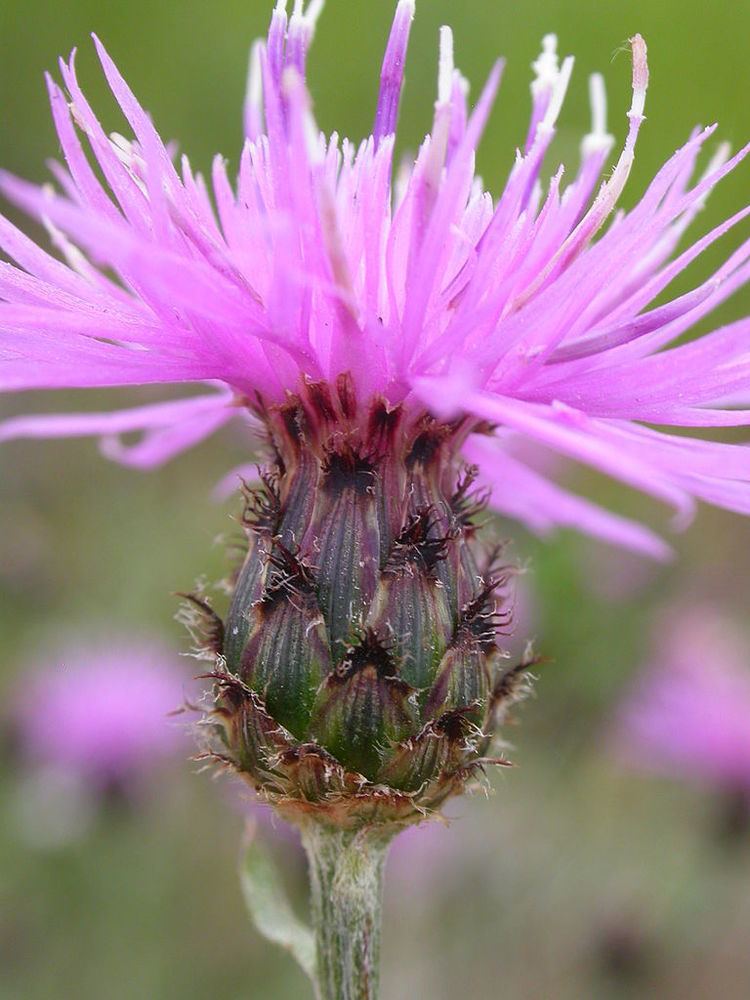
Centaurea maculosa, the spotted knapweed, is a species of Centaurea native to eastern Europe. This short-lived perennial usually has a stout taproot, pubescent stems with wooly or cobwebby hairs when young. The erect or ascending plant stems grow 20 to 150 cm tall. It grows on stream banks, pond shorelines, sand prairies, old fields and pastures, roadsides, and along railroads, and many open, disturbed areas. Apparently, is should be treated with two varieties as (Centaurea stoebe var. stoebe and var. micranthos (S.G. Gmel. ex Gugler) Hayek.
Invasive plant

It has been introduced to North America, where it is considered an invasive plant species in much of the western United States and Canada. In 2000, C. maculosa occupied more than 7 million acres (28,000 km2) in the US.
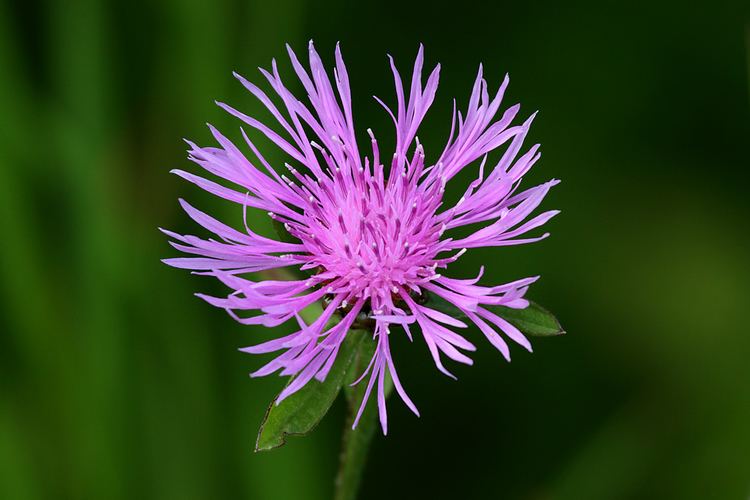
Knapweed is a pioneer species found in recently disturbed sites or openings. Once it has been established at a disturbed site, it continues to spread into the surrounding habitat. This species outcompetes natives through at least three methods:

- A tap root that sucks up water faster than the root systems of its neighbors,
- Quick spread through high seed production, and
- Low palatability, meaning it is less likely to be chosen as food by herbivores. It is also suspected to be allelopathic, releasing a toxin from its roots that stunts the growth of nearby plants of other species.
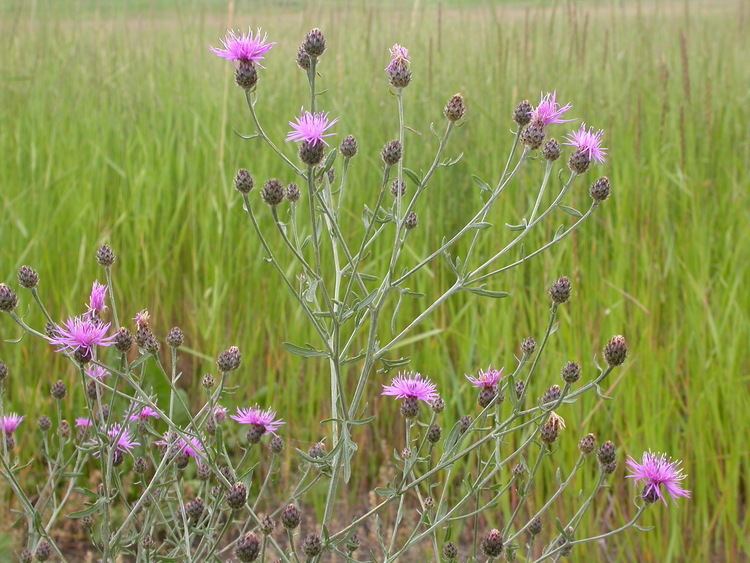
Its seed is an achene about a quarter of an inch long, with a small bristly pappus at the tip which makes the wind its primary means of dispersal. The leaves are a pale grayish-green. They are covered in fine short hairs. First year plants produce a basal rosette, alternate, up to 6 inches (150 mm) long, deeply divided into lobes. It produces a stem in its second year of growth. Stem leaves are progressively less lobed, getting smaller toward the top. The stem is erect or ascending, slender, hairy and branching, and can grow up to three feet tall. Because cattle prefer the native bunchgrass over knapweed, overgrazing occurs, increasing the density and range of knapweed infestations. Human disturbance is also a major cause of infestations. Knapweed readily establishes itself and quickly expands in all growth forms in places of human disturbance such as industrial sites, along roadsides, and along sandy riverbanks, and also has the potential to spread into undisturbed natural areas.
Biocontrol
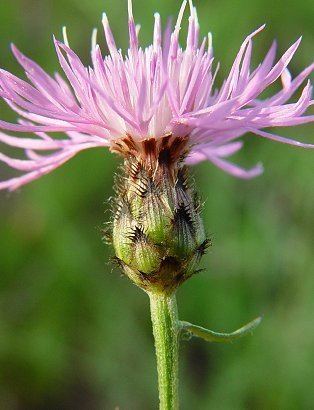
Thirteen biological pest control agents have been used against this plant and its cogener, diffuse knapweed, including the moths Agapeta zoegana and Metzneria paucipunctella, the weevils Bangasternus fausti, Larinus obtusus, and Larinus minutus and Cyphocleonus achates, and the fruit flies Chaetorellia acrolophi, Urophora affinis and Urophora quadrifasciata. But in general, biocontrol has not been shown to be effective against C. maculosa. In some instances, root-herbivory on C. maculosa stimulates additional release of catechin, the main allelopathic chemical which the species emits. In addition, moderate levels of herbivory by biocontrol agents can cause compensatory growth.
Prescribed grazing
Prescribed grazing may be an effective means of controlling infestations. All growth forms are nutritious to sheep. High-density infestations can be controlled by fencing in the control area with sheep until the desired level of removal is achieved.
Allelopathy via catechin
The roots of C. maculosa exude (-)-catechin. This acts as an herbicide to inhibit competition by a wide range of other plant species. This phytotoxic compound inhibits seed germination and growth in making phosphorus more available in certain soils. It leads to cell death of competing plants by acidification of the cytoplasm. Some natives, such as Gaillardia grandiflora and Lupinus sericeus, are resistant to catechin-induced toxicity. This resistance is conferred by these plants' ability to produce oxalate. Furthermore, native grasses grown in conjunction with oxalate-producing plants benefited from presence of oxalate.
Impact in North America
Spotted knapweed likely spread to North America in an alfalfa shipment. It was first recorded in Bingen, Klickitat County, Washington in the late 1800s; by 1980, it had spread to 26 counties in the Pacific Northwest. In the year 2000 it was reported in 45 of the 50 states in the US. Spotted knapweed primarily affects rangelands of the northwest United States and Canada. A 1996 study estimated the direct plus secondary economic impact of spotted knapweed in Montana to be approximately $42 million annually. When spotted knapweed replaces native grasses, soil erosion and surface runoff are increased, depleting precious soil resources.
In 2015, a Missoula, Montana beekeeper whose bees rely on local knapweed stated that "knapweed produces great honey ... people should consider planting native wildflowers instead of just taking out weeds."
Nomenclature
The common name spotted knapweed most often refers to Centaurea maculosa; however, inconsistencies exist in the scientific community. Two cytotypes of the plant exist which have been named as either different species or subspecies. Centaurea maculosa has been used to describe the diploid and tetraploid form, however the diploid form has been called Centaurea stoebe which, having been published before C. maculosa, is the correct name for the species and the tetraploid form Centaurea biebersteinii.
